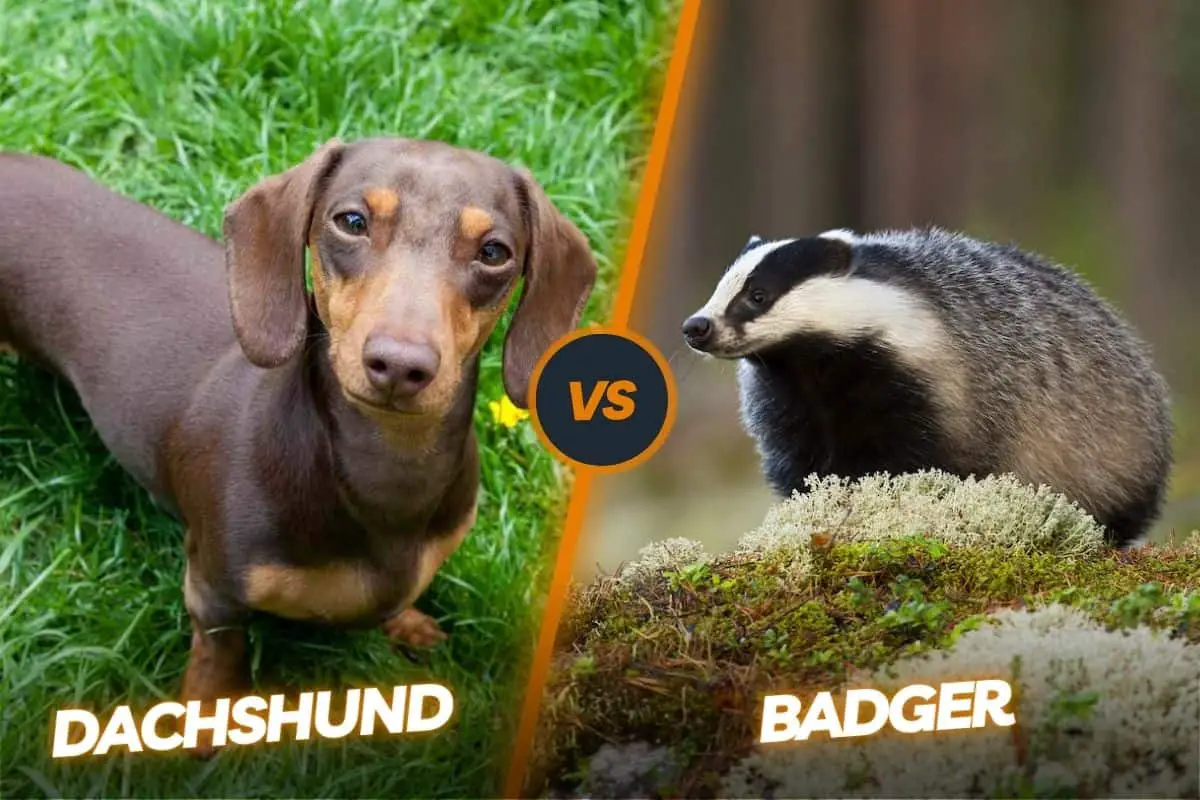Dachshund vs badger are two fascinating creatures that have captured the attention of many people around the world. While they may seem like an unlikely pair to compare, there are actually several similarities and differences between these two animals that make them an interesting subject of study.
Dachshunds, renowned for their unique appearance and exceptional hunting skills, are frequently employed by people for the specific purpose of hunting badgers. They have a long body, short legs, and a distinctive elongated shape that sets them apart from other dog breeds. Badgers, on the other hand, are small mammals that belong to the Mustelidae family. They have a stout body, short legs, and a low-slung profile that allows them to move easily through underground burrows. People often use Dachshunds to hunt for badgers.
The reason why dachshunds and badgers are being compared is because of their physical similarities and their shared hunting instincts. Despite their different evolutionary paths, these two animals have developed similar characteristics and behaviors that allow them to thrive in their respective environments.
Physical Characteristics: How Dachshunds and Badgers Look Alike and Differ
When it comes to physical characteristics, dachshunds and badgers share some similarities but also have distinct differences. Both animals have a long body and short legs, which gives them a low-slung appearance. However, dachshunds tend to have a more elongated shape compared to badgers, with a longer torso and shorter legs.
In terms of size, dachshunds are generally smaller than badgers. The average dachshund weighs between 16 to 32 pounds, while badgers can weigh anywhere from 10 to 35 pounds depending on the species. Additionally, dachshunds come in a variety of colors and patterns including red, black, tan, and dapple, while badgers are typically gray or black with white markings.
These physical characteristics have evolved to help both dachshunds and badgers in their respective environments. The long body and short legs of dachshunds allow them to easily maneuver through tunnels and burrows when hunting prey. Similarly, badgers’ stout bodies and short legs are well-suited for digging and navigating underground tunnels.
Hunting Instincts: The Similarities and Differences in Their Hunting Styles
Both dachshunds and badgers are natural hunters with a strong instinct for tracking and capturing prey. However, their hunting techniques and strategies differ due to their different environments and prey preferences.
Dachshunds were originally bred for hunting small game such as badgers, rabbits, and foxes. They have a keen sense of smell and excellent tracking abilities, which they use to locate their prey. Once they have found their target, dachshunds will use their long bodies and short legs to chase the prey into its burrow or den. They are known for their tenacity and determination when it comes to hunting, often refusing to give up until they have caught their prey.
Badgers, on the other hand, are primarily nocturnal hunters that feed on a variety of small animals including rodents, insects, and amphibians. They use their strong claws and powerful jaws to dig into the ground and uncover their prey. Badgers are skilled diggers and can quickly excavate burrows or tunnels in search of food. Unlike dachshunds, badgers rely more on their physical strength rather than speed when hunting.
Diet and Nutrition: What Dachshunds and Badgers Eat and How They Get Their Food
Dachshunds and badgers have different dietary preferences but share some similarities in how they obtain their food in the wild.
Dachshunds are carnivores that primarily eat meat. Their diet consists of a variety of animal proteins including chicken, beef, and fish. They also require a balanced diet that includes essential nutrients such as vitamins and minerals. In the wild, dachshunds would rely on their hunting skills to catch small game for food. However, as domesticated pets, they are typically fed commercial dog food that is specially formulated to meet their nutritional needs.
Badgers, on the other hand, have a more varied diet that includes both animal and plant matter. They are opportunistic feeders and will eat whatever is available in their environment. Their diet consists of small mammals, birds, reptiles, insects, fruits, nuts, and roots. Badgers are skilled foragers and will dig up the ground in search of food. They have a strong sense of smell that helps them locate buried prey or hidden food sources.
Social Behavior: How Dachshunds and Badgers Interact with Each Other and Their Environment
Both dachshunds and badgers are social animals that interact with each other and their environment in unique ways.
Dachshunds are known for their loyalty and affection towards their human companions. They are highly social dogs that thrive on human interaction and companionship. Dachshunds are also known to be good with children and other pets when properly socialized. In the wild, dachshunds would live in packs or small groups, working together to hunt and protect their territory.
Badgers, on the other hand, are solitary animals that prefer to live alone or in small family groups. They are territorial creatures that mark their territory with scent markings and defend it from intruders. Badgers have a complex social structure within their family groups, with dominant individuals leading the group and younger members learning from their elders. They communicate with each other through vocalizations, scent markings, and body language.
Communication: The Surprising Ways Dachshunds and Badgers Communicate with Each Other
Dachshunds and badgers have different ways of communicating with each other, but both animals rely on a combination of vocalizations, scent markings, and body language to convey messages.
Dachshunds are known for their distinctive barks and howls, which they use to communicate with their owners and other dogs. They have a wide range of vocalizations that can express different emotions such as excitement, fear, or aggression. Dachshunds also use their body language to communicate, with tail wagging, ear position, and facial expressions conveying their mood or intentions.
Badgers, on the other hand, communicate primarily through scent markings. They have scent glands located on various parts of their body, including their anal glands, which they use to mark their territory. These scent markings contain information about the badger’s identity, reproductive status, and social rank. Badgers also use vocalizations such as growls, hisses, and snorts to communicate with each other.
Adaptability: How Dachshunds and Badgers Have Evolved to Survive in Different Environments
Dachshunds and badgers have evolved different adaptations that allow them to survive in their respective environments.
Dachshunds have been selectively bred for their hunting abilities and physical characteristics that make them well-suited for hunting small game in underground burrows. Their long bodies and short legs allow them to easily navigate through tunnels and burrows, while their keen sense of smell helps them locate prey. Dachshunds also have a strong prey drive and tenacity that make them excellent hunters.
Badgers, on the other hand, have evolved adaptations that allow them to thrive in a variety of habitats including forests, grasslands, and deserts. Their stout bodies and short legs are well-suited for digging into the ground and creating burrows. Badgers also have sharp claws and powerful jaws that help them excavate burrows and capture prey. Additionally, badgers have a thick coat of fur that provides insulation and protection from the elements.
Domestication: The History of Dachshunds and How They Became Popular Pets
Dachshunds have a long history that dates back several centuries. They were originally bred in Germany in the 17th century for hunting purposes. Their long bodies and short legs were specifically selected to make them effective hunters in underground burrows. Over time, dachshunds became popular with the nobility and were eventually recognized as a distinct breed.
In the 19th century, dachshunds were introduced to other countries including England and the United States. They quickly gained popularity as companion dogs and were also used for hunting small game. Today, dachshunds are one of the most popular dog breeds in the world and are known for their playful and affectionate nature.
Badgers, on the other hand, have not been domesticated like dachshunds. They are wild animals that are protected by law in many countries due to their declining populations. Badgers are often associated with folklore and mythology, and their distinctive appearance has made them a symbol of strength and determination.
Conservation: The Importance of Protecting Badgers and Their Natural Habitat
Badgers are facing numerous threats to their survival, including habitat loss, persecution, and disease. Their natural habitat is being destroyed or fragmented by human activities such as agriculture, urbanization, and infrastructure development. This loss of habitat makes it difficult for badgers to find suitable places to live and forage for food.
Badgers are also persecuted by humans due to conflicts with agriculture or fears of spreading disease. In some countries, badgers are culled in an attempt to control the spread of bovine tuberculosis, which can be transmitted between badgers and cattle. However, there is ongoing debate about the effectiveness and ethics of badger culling as a disease control measure.
Protecting badgers and their natural habitat is important for maintaining biodiversity and ecosystem balance. Badgers play a crucial role in their ecosystems by controlling populations of small mammals and insects. They also help to aerate the soil through their digging activities, which can benefit plant growth and nutrient cycling.
Conclusion: The Unique and Intriguing Similarities and Differences Between Dachshunds and Badgers
In conclusion, dachshunds and badgers are two fascinating creatures that share some surprising similarities and differences. Despite their different evolutionary paths, these animals have developed physical characteristics, hunting instincts, social behaviors, communication methods, and adaptations that allow them to thrive in their respective environments.
Dachshunds are domesticated dogs that have been selectively bred for their hunting abilities and distinctive appearance. They are loyal and affectionate companions that have become popular pets around the world. Badgers, on the other hand, are wild animals that are facing numerous threats to their survival. They play an important role in their ecosystems and are protected by law in many countries.
Studying the similarities and differences between dachshunds and badgers not only provides us with a better understanding of these animals but also highlights the importance of conservation efforts to protect their natural habitats. By appreciating the unique qualities of these creatures, we can work towards creating a world where both dachshunds and badgers can thrive.
Originally posted 2023-05-01 08:46:59.
Johny is a dedicated pet enthusiast, author, and the driving force behind the insightful content at PetSWAT. With a deep passion for animals and a wealth of knowledge acquired through years of experience, Johny brings a unique perspective to the world of pet care and companionship.


